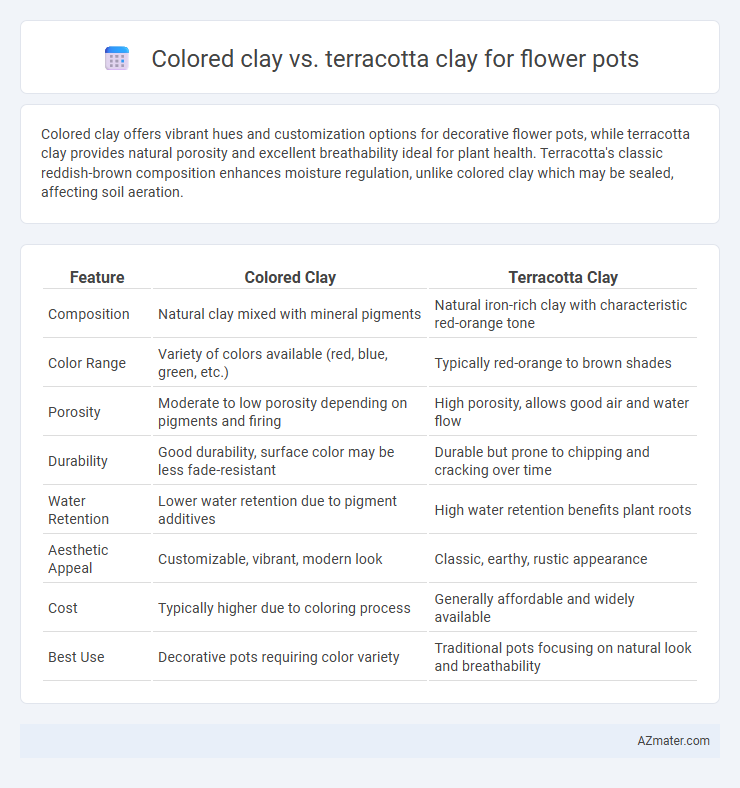Colored clay offers vibrant hues and customization options for decorative flower pots, while terracotta clay provides natural porosity and excellent breathability ideal for plant health. Terracotta's classic reddish-brown composition enhances moisture regulation, unlike colored clay which may be sealed, affecting soil aeration.
Table of Comparison
| Feature | Colored Clay | Terracotta Clay |
|---|---|---|
| Composition | Natural clay mixed with mineral pigments | Natural iron-rich clay with characteristic red-orange tone |
| Color Range | Variety of colors available (red, blue, green, etc.) | Typically red-orange to brown shades |
| Porosity | Moderate to low porosity depending on pigments and firing | High porosity, allows good air and water flow |
| Durability | Good durability, surface color may be less fade-resistant | Durable but prone to chipping and cracking over time |
| Water Retention | Lower water retention due to pigment additives | High water retention benefits plant roots |
| Aesthetic Appeal | Customizable, vibrant, modern look | Classic, earthy, rustic appearance |
| Cost | Typically higher due to coloring process | Generally affordable and widely available |
| Best Use | Decorative pots requiring color variety | Traditional pots focusing on natural look and breathability |
Introduction to Colored Clay and Terracotta Clay
Colored clay, often enriched with minerals and pigments, offers vibrant hues and enhanced durability for flower pots, making them a popular choice for decorative gardening. Terracotta clay, a natural earthenware made from refined red or orange clay, provides excellent porosity and breathability, which promotes healthy root growth and moisture regulation. Both materials cater to different aesthetic and functional preferences, with colored clay focusing on visual appeal and terracotta emphasizing natural, breathable qualities.
Key Differences Between Colored Clay and Terracotta Clay
Colored clay offers enhanced aesthetic versatility by allowing a wide range of vibrant hues, whereas terracotta clay is naturally reddish-brown due to its iron content. Terracotta clay is porous, providing excellent breathability and moisture regulation for plants but requires sealing to prevent water damage, unlike colored clay which often incorporates additives for improved durability and water resistance. The firing temperature for terracotta typically ranges between 1000-1150degC, producing a denser pot compared to some colored clays that may fire at lower temperatures and remain more fragile.
Visual Appeal: Aesthetic Options for Flower Pots
Colored clay offers a vibrant palette that enhances flower pots with bold, custom hues suitable for modern and eclectic designs. Terracotta clay provides a natural, earthy tone that ages gracefully, delivering a classic, rustic aesthetic favored in traditional and Mediterranean-style gardens. Both materials allow for unique visual expressions, but colored clay supports greater versatility in color customization, while terracotta's warm, organic look creates timeless charm.
Durability and Strength Comparison
Terracotta clay is renowned for its porous nature, allowing better breathability but making it more prone to cracking under extreme weather or impact, whereas colored clay pots often receive additional treatments or glazing that enhance their durability and resistance to moisture. The firing process of terracotta generally results in a softer, more brittle material compared to colored clay variants, which may incorporate additives or higher firing temperatures to improve structural strength. For long-term use, colored clay pots tend to offer superior resilience against chipping and environmental wear, making them a preferable choice for outdoor flower pots requiring greater durability.
Water Retention and Breathability Factors
Colored clay flower pots often contain additional pigments and additives that can slightly reduce their water retention and breathability compared to traditional terracotta clay. Terracotta clay is porous, allowing for excellent breathability and natural moisture evaporation, which benefits plant root health by preventing waterlogging. The enhanced water retention of colored clay pots may be advantageous for plants needing consistent moisture but can risk reduced aeration in the root zone.
Suitability for Different Plant Types
Colored clay offers enhanced aesthetic appeal and is often coated with a protective glaze, making it suitable for moisture-loving plants that require consistent hydration. Terracotta clay is porous and breathable, providing excellent drainage and aeration ideal for succulents, cacti, and drought-tolerant plants. The choice between colored and terracotta clay pots depends on the specific water retention needs and root oxygen requirements of the plant species.
Environmental Impact and Sustainability
Colored clay flower pots often involve synthetic dyes and chemical treatments that may release pollutants during production, raising environmental concerns. Terracotta clay pots are made from natural, porous clay fired at low temperatures, making them biodegradable and highly sustainable due to their minimal processing and natural composition. The use of terracotta enhances soil aeration and water retention while reducing ecological footprints compared to colored clay alternatives containing artificial additives.
Cost Considerations and Availability
Colored clay flower pots typically cost more due to the added pigments and processing involved, while terracotta clay pots are generally more affordable and widely available. Terracotta's natural reddish-brown hue is sourced from abundant local clay deposits, making it a cost-effective option for large-scale production. Colored clay requires specialized manufacturing, resulting in less availability and higher prices compared to frequently stocked terracotta pots.
Maintenance and Longevity of Pots
Colored clay pots often have a glazed finish that enhances resistance to moisture and stains, reducing maintenance requirements compared to unglazed terracotta pots. Terracotta clay pots are porous, allowing air and water to pass through but are prone to cracking in extreme weather and require regular sealing or protective treatments to prolong longevity. Both types benefit from proper care, but colored clay pots generally offer greater durability and lower upkeep for long-term use in flower pot applications.
Choosing the Right Clay for Your Garden
Colored clay offers vibrant hues and adds aesthetic appeal to flower pots, making it ideal for decorative garden elements. Terracotta clay is porous, ensuring excellent breathability and moisture regulation, which promotes healthy plant roots in outdoor settings. Selecting between colored and terracotta clay depends on whether visual impact or functional benefits like water drainage and root aeration are prioritized in your garden design.

Infographic: Colored clay vs Terracotta clay for Flower pot
 azmater.com
azmater.com